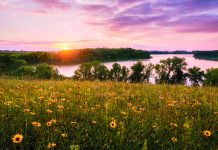
Photo by Ryan Taylor
In Minnesota, people-powered water sports have traditionally started and ended with canoeing and kayaking. (Aside from some gnarly waves on Superior, we’ve got 9,999 relatively placid lakes.) If Emily Hendricks and Emily Carey have anything to say about it, however, a newcomer with surfing in its DNA is about to take over. Make way for SUP.
“I love to be on top of the water,” Hendricks says. “It’s being able to see down into the world that you never really get to look at when you’re canoeing or kayaking or on a boat. You can paddle intensely, you can float and have a beer. I like to do it all!”
Hendricks works in IT and caught the stand-up paddleboard bug almost a decade ago during a trip to Hawaii. After a few years of lobbying her college buddy Carey to join the movement, the pair started an Instagram account called Paddle Flat (@paddleflat). They hope it will serve as a resource for the freshwater SUP scene in the Upper Midwest.
“The freedom of not having walls, the ability to sprawl out on your board, your arms can be hanging in the water—you kind of meld into nature at that point,” Hendricks continues.
Carey, a videographer and photographer from St. Paul, was drawn to the sport’s unique physical challenges and undeniable aesthetic appeal. Keeping balance on these long boards is easier than you might think, but it also requires the paddler to engage a symphony of underutilized core muscles. Toss in some techniques from yoga, which both Emilys enthusiastically practice on land and sea, and you have a recipe for a truly unique workout.
“Take everything you know about yoga and throw it out the window, because [SUP yoga] flips you literally upside down,” Carey jokes. “The simplest pose that you can do on land—it’s completely different on a board. You’re not only trying to balance normally; you’re also having to deal with waves that are constantly shifting you.”
The simplicity of SUP makes it a perfect blank canvas for such creative pursuits, and also lowers the bar for access. Once you get over your fear of falling in the water—and the Emilys promise that you will—the sport is refreshingly austere. It requires little in the way of additional equipment beyond a board, paddle, and life preserver. Paddle Flat suggests a dry bag, to keep your phone and other gadgets safe, and that’s about it.
Once you’re on the board itself, Carey and Hendricks recommend balancing on your knees before climbing to your feet. Then, rock side to side to get used to the board’s balance point. Paddle technique borrows some basic skills from canoeing, but SUP demands straight arms and stacked hands for you to glide forward in style.
“I think it’s incredibly peaceful,” Carey says. “The first thing that I want to do when I get on a lake is paddle out and just sit and experience what’s happening. It’s a very zen moment, and it’s very calming. I find a lot of joy from those quieter, slower, peaceful paddles. It’s early morning, there’s fog on the lake, and there’s nothing out there but you and a paddleboard. That for me is a perfect day.”
Rent or Buy a SUP
Wheel Fun Rentals
Wheel Fun is a national chain with four lakeside locations in the Twin Cities (Bde Maka Ska, Harriet, Nokomis and Phalen). Rent full-size paddleboards for $21 an hour, $51 for a half day, or $71 for a full day.
Wai Nani Surf & Paddle
Parked on the shores of Lake Minnetonka, Wai Nani offers several of the major SUP brands, plus rentals, lessons, guided tours, SUP Yoga classes, and much more.
Midwest Mountaineering
Expect a wide selection of SUPs, like Grey Duck SUP (one of MN’s in-state SUP makers), rentals and demo rides for newer paddlers, and even SUP-related classes and events.








